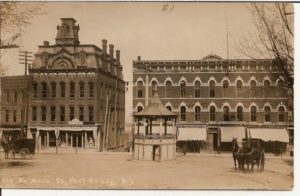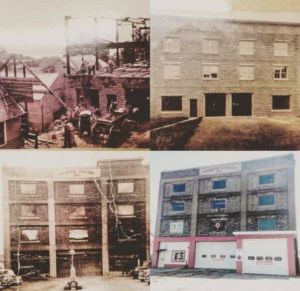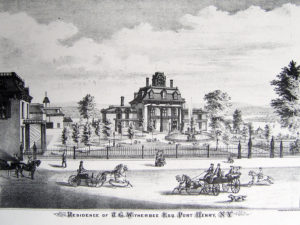Andebit et beaqui corendit, ut quostes esciendion re dit ad et prae parion es quia quas alibus sam, omnim faciden ducipidiat arum autem nobis enis es voat

24. Port Henry
The Cultural Legacy of Mining’s Wealth
Listen to the Audio Narration of the Iron Story Site 24

While Witherbee and Moriah may have been the site of most of the iron ore and the industrial structures that were required to process it, Port Henry was the site of immense railyards, shipping wharves, and blast furnaces along the lakeshore. Yet Port Henry—in contrast to Witherbee and Mineville—physically reflected the great wealth that mining and manufacturing had created. It was in Port Henry where the large estates of the company owners, complete with their mansions, gardens, and greenhouses, stood. By 1923, north and south Main Street in Port Henry had been paved, using iron tailings as part of the paving material.Port Henry fostered a broad variety of cultural and civic initiatives. The Port Henry Musical Association, which gave a number of concerts, formed during the 1860s, enriching the cultural lie of the town. The Lewald Opera House, built in 1874, was an integral part of the village square—which was also home to a bandstand—and helped make theatrical events commonplace in Port Henry during the late 1800s. The town’s own Tromblee Quartet was considered the best male quartet in the state, and the Port Henry Cornet Band was considered the best band north of Troy, often making excursions to Plattsburgh and Burlington to perform. Beyond music, the town also was home to boating regattas, a yacht club at Powerhouse park, the American Canoe Association, a golf course, a country club with tennis courts, and a horse racetrack (Listen to audio from 21, Driving Switchback and Cheney Roads).Later, Port Henry became an important filming location or many silent-era films in the early 20th century. Arctic City Film Studio, popular for filmmaking between 1914-1929, was based in Port Henry.
It was niceties like this that further differentiated the class distinctions between the wealthy of Port Henry and the working class.
The cultural legacy of the Witherbees and the Shermans is still visible in the town’s landmark buildings. Built by the company or family members, these buildings reflect a period of tremendous prosperity in the town (between 1870 and 1875 the town’s population jumped from 4,683 to 7,898).
Glens Falls National Bank & Trust: Construction of this Neoclassical-style bank was completed in 1908, which, at the time was the First National Bank of Port Henry. Witherbees and Shermans were among the initial shareholders and members of the Board of Directors.
Sherman Free Library: This is one of many buildings in Port Henry that exists because of George R. Sherman, representing his interest in bringing culture to Port Henry in its heyday. Designed in the Richardson-Romanesque style and built at a cost of $7,700 in 1887-88, Sherman stocked the shelves with 3,000 books and endowed the library $10,000 to maintain its operation. When Jane Sherman, George’s wife, died, she endowed the library another $10,000 in her will. The building was doubled in size in 1907 and remains open for all citizens of Port Henry, just as Sherman intended. Step inside to see the still-intact oak interior and brass light fixtures—as well as portraits of Frank S. Witherbee and George R. Sherman, and a very helpful Bird’s Eye Map of Port Henry from the early 1900s.
Mount Moriah Presbyterian Church: In 1888, the Mount Moriah Presbyterian church replaced the smaller First Presbyterian Church that was already on site. And it is another example of a Richardson-Romanesque-style building provided by George Sherman (the construction cost $9,236).

Henry’s Garage / Port Henry Fire Department:
From livery stable to car garage to fire station, this building reflects the developing history of Port Henry. Both its steel frame construction and automobile elevator aroused considerable interest locally, along with its considerable scale; it was clearly a forward-looking building erected on modern terms to satisfy increasingly modern needs. Perhaps more consequentially, it served as the first major expression in Port Henry of the new automobile age that was then emerging and which would soon radically transform American life. In 1903, C.W. Henry opened a livery and feed stable. But by 1908, Henry was looking ahead to the automobile. When President Taft visited Port Henry in 1909, a guidebook listed Henry’s as “the chief livery in this section…. [with] three automobiles.” C.W.’s son Earl would design their new automobile and service garage for his senior thesis at Rensselaer Polytechnic Institute in 1910. Tailings from the nearby mine were hauled over by wagon and concrete blocks were made on site. The three-story building was finished in 1911. By 1917, the building had expanded on the front. A heavy freight elevator transported cars between levels. Business kept up until 1970, when the mining industry declined. Since 1971, Henry’s has been the home of the fire station.
Lee House: The Lee house was built as a hotel in the 1870s, and later enlarged, boasting 50 rooms and one of the first Otis elevators in the country. It was here that the Rensselaer Polytechnic Institute students stayed when they came for school trips to visit the mines and furnaces. This Italianate-style building now houses senior citizens.

Ledgeside (The Frank S. Witherbee House):
What is now a supermarket and parking lot was once the grand lawn of Ledgeside, with formal gardens, fountains, and wrought-iron fencing. In 1957, a supermarket built over the grounds of the estate. Though no longer easily visible, the French Second Empire house with its prominent roof and projecting dormers remain well preserved. President McKinley visited here in the summer of 1897 as a guest of Frank Witherbee. The building now houses a variety of offices.
Walter C. Witherbee Mansion: On Broad Street hill, on the corner of Stone Street, Walter Witherbee’s home, built in the 1890s, is probably one of the grandest residences in Port Henry. Designed in the Shingle style, the house also contains two corner towers. It is now privately owned.
Travel Tools
Park where convenient in downtown Port Henry. Download the Adirondack Architectural Heritage Walking Tour with map.


